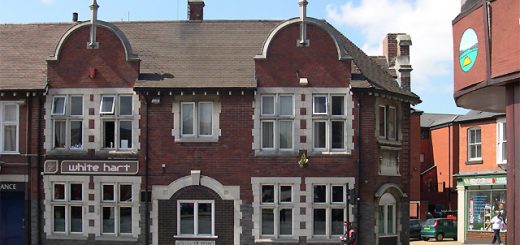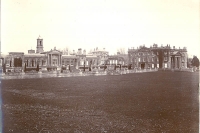The Devil of Drakelowe
In ‘Collections for a history of Staffordshire’ (1880) we are introduced to the following account of the events surrounding the case know as The Devil of Drakelowe and the abandonment of the hamlet. The story may have its origins in the Anglo Saxon meaning of Drakelow, ‘Dragons Mound’ which may indicate a burial site with a guardian spirit.
‘One single narrative, part legendary, part historical, has preserved some notice of Drakelowe in the years immediately following the Great Survey*. Dugdale in his Monasticon Anglicanum quotes the Chronica Abbatum de Burton (a sixteenth century manuscrip) which testifies to a common saying ‘The Devill of Drakelowe’, and states Dugdale that it arose from a story of two Stapenhill rustics who fled from the Abbot of Burton to Roger the Poitevin, and for their faithlessness brought down the vengeance of Modwenna the patron saint of Burton Abbey. The Chronicle also states that this was during the abbacy of Galfridus de Mala Terra, who was abbot in 1085-94, so these events probably took place during the period 1090-94, when Drakelowe was held by Roger for the second time. The only surviving narrative is the Tractatus de Miraculis which follows the Life of St. Modwenna written by Gaufridus, who was Abbot of Burton 1114-51 and who may well have been a contemporary witness.
The tractate states that two villeins who lived at Stapenhill under the jurisdiction of the abbot of Burton fled ad uillam proximam que Drachelawa dicitur, relinquentes inique dominos suos monachos et manere cupientes sub potestate Rogerii Comitis qui Pictauensis cognominabatur. [to the nearby village called Drakelowe, unjustly forsaking their masters the monks and desiring to stay under the authority of Count Roger nicknamed the Poitevin]. The abbey officers promptly seized the corn which was to have been given out to the delinquents, who meanwhile told the Count so mendacious a story, as the chronicle says, that he threatened the abbot, seized all the corn at Stapenhill, and sent soldiers to the abbey lands at Blakepol, who challenged the abbot’s ten soldiers to fight. The abbot rushed to St. Modwenna’s shrine, while his ten retainers, against orders, sallied forth and fought sixty of the Count’s followers including the dapifer Comitis [the Count’s seneschal], with varying results. The day after the two refugees were seized with illness, died, and were buried the next morning at Stapenhill in wooden coffins (archae ligneae).
Then followed a terrible scene. That same evening before sunset the figures of these two were seen bearing their coffins in fantastic fashion on their shoulders and rushing about the paths and fields at Drakelowe, assuming the appearance of bears or hounds or other animals. This continued all night, and the position became intolerable when these creatures began to bang their coffins against the walls of the houses, crying, “Forward, forward with haste, bestir yourselves and come.’ Every evening and every night this happened, till, to cap everything, an epidemic seized the place and nearly everybody died, except two rustics and Drogo the Count’s bailiff.
The Count went in penitence to the abbot, and made full restitution, but the Saint was not so easily pacified as her Abbot. The two rustics themselves fell ill, and some neighbours, still in deadly fright of the nocturnal visitants, exhumed the bodies of the two original refugees, bore off their hearts ad collem qui Dodefreseford nuncupatur [to the hill called Dodefreseford], and burnt them there. Just as this was completed an evil spirit in the shape of a flying crow was seen to emerge from the flames. This was no doubt the Devil of Drakelowe, and his appearance sent every one into ecstasies of fright. Even the two rustics, as soon as they saw the smoke of the fire, suddenly found themselves quite well enough to rise from their beds and flee with wives and children, bag and baggage, ad uillam proximam que Greseleia dicitur. Thus was Drakelowe utterly depopulated, and remained so for a long time, such fear was there of the wrath of St. Modwenna and such wonder at the miracles wrought for her sake.
So runs the legend, and we can see through it with some certitude a quarrel between Roger the Poitevin and the Abbot of Burton, an encounter between their retainers, and an epidemic disease which shortly after depopulated Drakelowe and caused a migration of rich and poor to Gresley.’




Recent Comments